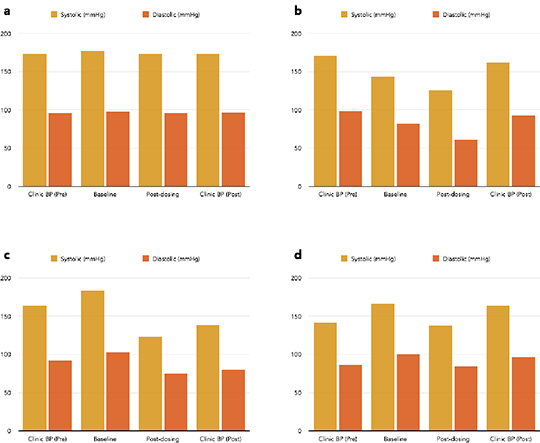Diagnostic and Therapeutic Value of Supervised Dosing in Resistant Hypertension INTRODUCTION: Resistant hypertension remains a challenge. Defined as sub-optimal blood pressure (BP) control in patients on at least three, maximally tolerated, anti-hypertensive drugs, it represents a significant risk for patients and an economic burden to health care services. However, ‘true’ resistance is often masked by non-adherence. This may be delineated through supervised dosing (SD). METHODS: A retrospective study was conducted in 15 patients with resistant hypertension, in whom SD had been carried out between June 2009 and August 2014. All BP data were based on the mean of three individual readings at any given time point, with the same arm utilised on all occasions. A mean BP was calculated for all clinic visits prior to (pre-) and post-SD (mean number of clinic visits: 5, 5.5; respectively). On the day of SD, the “baseline” BP was recorded consistently within 30 minutes of arrival to clinic. “Post-dosing” BP was the lowest systolic blood pressure (SBP) achieved throughout SD.
Figure 1. Effects of supervised dosing on blood pressure in patients with resistant hypertension. a) True resistance (n=6); b) Pseudo-resistance with reduced baseline SBP on the morning of supervised dosing (n=4); c) Pseudo-resistance with improved SBP during clinic visits subsequent to supervised dosing (n=2); d) Sustained pseudo-resistance (n=4). DISCUSSION: From a small sample of patients with resistant hypertension, we have demonstrated that only 40% exhibit ‘true resistance’. The remaining 60% are pseudo-resistant, in keeping with published data (1). Whilst SD can distinguish between these two groups, we report its potential utility as a therapeutic intervention in 40% of patients with previously resistant hypertension and describe three discreet BP profiles associated with pseudo-resistance. As non-adherence is integral to our findings, further studies into the psychology of these three groups, may offer therapeutic insights. REFERENCES: (1) Bunker J et al. (2011). J Hum Hypertens 25: 137-140
|


